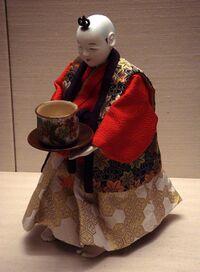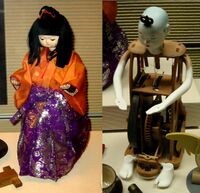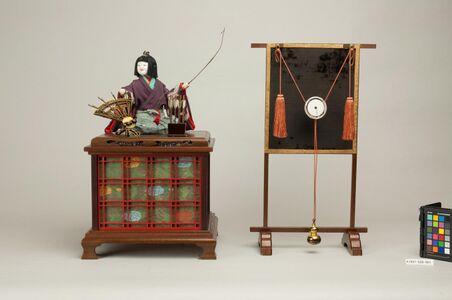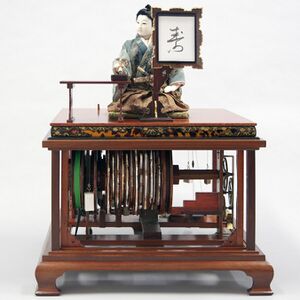Engineering:Karakuri puppet
Script error: The function "transl" does not exist. puppets (からくり人形 karakuri ningyō) are traditional Japan ese mechanized puppets or automata, made from the 17th century to the 19th century. The dolls' gestures provided a form of entertainment. The word Script error: The function "transl" does not exist. has also come to mean "mechanisms" or "trick" in Japanese.[1] It is used to describe any device that evokes a sense of awe through concealment of its inner workings.[2]
The name Script error: The function "transl" does not exist. is thought to come from the Japanese verb Script error: The function "transl" does not exist., which means "to pull, stretch, and move a thread".[3] It is alternatively written in kanji as 絡繰り, 絡繰, 機巧, 機関, and archaically as 唐繰.
History
One of the earliest recorded references in Japan to similar automata devices is found in the Script error: The function "transl" does not exist., which references a mechanism known as a south-pointing chariot appearing during the reign of Empress Kōgyoku, in 658 CE.[4]
Script error: The function "transl" does not exist. were further developed in Japan after the introduction of European clock-making technology sometime in the early 17th century, during the Sengoku period.[5] The gears and cams used in clock-making were used to create moving dolls. The country embraced the mechanized puppet performance as a form of entertainment, and it became popular during the Edo period, which was considered the golden age of Script error: The function "transl" does not exist. construction and use.[5]
Script error: The function "transl" does not exist. were initially only known to upper-class Japanese, such as Script error: The function "transl" does not exist. and Script error: The function "transl" does not exist., as the only members of society wealthy enough to afford them. However, Script error: The function "transl" does not exist. gained widespread popularity through their use as part of floats during street festivals, such as the Toshogu Matsuri in Nagoya.[6]
In 1662, clockmaker Takeda Omi completed the first Script error: The function "transl" does not exist., Script error: The function "transl" does not exist. designed for stage performances, in the Dōtonbori neighborhood of Osaka .[5] He then built several of these large puppets for theatrical exhibitions, and the theatre was passed down through several generations of his family.[5][7]
In the 19th century, Tanaka Hisashige, the founder of Toshiba, gained a reputation by making technically sophisticated Script error: The function "transl" does not exist. puppets. His masterpieces are Lua error in Module:Lang/utilities at line 268: attempt to call field '_transl' (a nil value). and Script error: The function "transl" does not exist. doll (letter-writing doll). In the case of Script error: The function "transl" does not exist., using mechanical power, a puppet shoots a target with a bow and arrow, and in the case of Script error: The function "transl" does not exist., a puppet a dips a brush into ink and writes characters on paper.[8]
According to Kirsty Boyle, a student of one of the last Script error: The function "transl" does not exist. puppet masters in Japan, the Script error: The function "transl" does not exist. tradition focuses on the art of concealing technology with the belief that it would evoke feelings and emotions more effectively.[9] It is also noted that, although the Script error: The function "transl" does not exist. puppet resembles the human figure, it has a form of decisive movement that features rapid shifts that cannot be captured by the naked eye.[10]
Types
There are three main types of Script error: The function "transl" does not exist..[11] Lua error in Module:Lang/utilities at line 268: attempt to call field '_transl' (a nil value). were life-sized dolls designed for public performances such as theatres.[12] Lua error in Module:Lang/utilities at line 268: attempt to call field '_transl' (a nil value). were small and used in homes. Most of them were set on a table and performed a dance or beat drums, but some were designed to serve tea or sake. These were significantly expensive, and usually owned by a Script error: The function "transl" does not exist. or other high-status person. Lua error in Module:Lang/utilities at line 268: attempt to call field '_transl' (a nil value). were large mechanical dolls used in religious festivals,[11] where the puppets were used to perform reenactments of traditional myths and legends.
There were also more inexpensive toys based on traditional Script error: The function "transl" does not exist.. The tin toys that for a period were frequently made in Japan and sold for export were sometimes modeled after Script error: The function "transl" does not exist..
Some scholars note that the gestures and movements of the Script error: The function "transl" does not exist. have influenced Noh, kabuki[5] and Script error: The function "transl" does not exist. theatre.
Script error: The function "transl" does not exist.
The most common example today of a Script error: The function "transl" does not exist. mechanism is a tea-serving robot, which starts moving forward when a cup of tea is placed on the plate in its hands. This Script error: The function "transl" does not exist., also known as Script error: The function "transl" does not exist.,[13] was used in a situation when a host wanted to treat a guest in a recreational way. It moves in a straight line for a set distance, moving its feet as if walking, and then bows its head. The doll stops when the cup is removed. When it is replaced, the robot raises its head, turns around and returns to where it came from. It is typically powered by a wound spring made of whalebone, and the actions are controlled by a set of cams and levers.
Gallery
See also
- Animatronic
- Automaton
- Script error: The function "transl" does not exist.
- Japanese robotics
- Tanaka Hisashige
References
- ↑ Law, Jane Marie (1997). Puppets of Nostalgia – The Life, Death and Rebirth of the Japanese Awaji Ningyo Tradition. Princeton University Press. ISBN 978-0-691-02894-1.
- ↑ Shea, Michael (2015). "Karakuri: Subtle Trickery in Device Art and Robotics Demonstrations at Miraikan". Leonardo 48: 40–47. doi:10.1162/LEON_a_00936.
- ↑ Nihon-Daijiten-Kankōkai Tōkyō (2000). Nihon kokugo daijiten.. Shōgakukan. OCLC 835363391.
- ↑ Chronicles of Japan from the Earliest Times to A.D. 697/Book XXVI Nihongi: Chronicles of Japan from the Earliest Times to A.D. 697, Volume 2. https://en.wikisource.org/wiki/Nihongi: Chronicles of Japan from the Earliest Times to A.D. 697/Book XXVI.
- ↑ 5.0 5.1 5.2 5.3 5.4 Markowitz, Judith (2014). Robots that Talk and Listen: Technology and Social Impact. Berlin: Walter de Gruyter GmbH & Co KG. pp. 33. ISBN 9781614516033.
- ↑ "東海の山車祭り~生き続ける19世紀の都市文化". https://dashi-matsuri.com/series/tokainodashi/tk403.htm.
- ↑ "karakuri.info". http://karakuri.info/butai/index.html.
- ↑ Hisashige Tanaka (1799-1881). The Seiko Museum Ginza.
- ↑ Cheok, Adrian David; Zhang, Emma Yann (2019). Human–Robot Intimate Relationships. Cham: Springer. pp. 2. ISBN 978-3-319-94729-7. https://books.google.com/books?id=-MOHDwAAQBAJ&q=karakuri+puppet&pg=PA2.
- ↑ Hendry, Joy; Raveri, Massimo (2005). Japan at Play. London: Routledge. pp. 74. ISBN 0203996569. https://archive.org/details/japanatplay00hend.
- ↑ 11.0 11.1 Lunning, Frenchy (2008). Mechademia 3: Limits of the Human. Minneapolis, MN: University of Minnesota Press. pp. 231. ISBN 9780816654826.
- ↑ Brown, Steven T. (2010). Tokyo Cyberpunk: Posthumanism in Japanese Visual Culture. New York: Palgrave Macmillan. pp. 32. ISBN 9780230103597.
- ↑ Bock, Thomas; Linner, Thomas (2015). Robotic Industrialization. New York: Cambridge University Press. pp. 98. ISBN 978-1-107-07639-6.
External links
- Karakuri.info English information site
- Karakuri puppets in Takayama Matsuri Festival NHK (video)
 |










